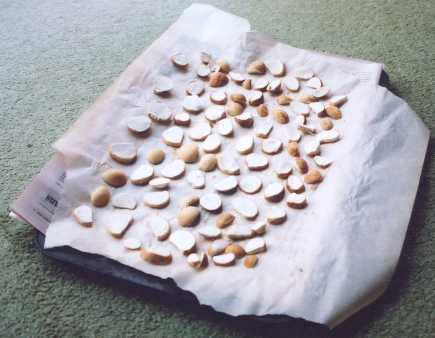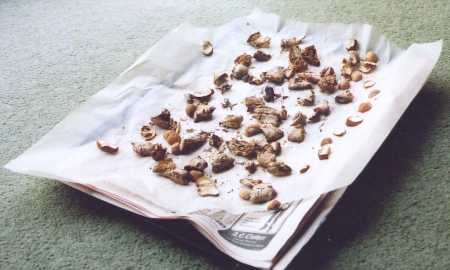
|

|
Or, what to do with a really big haul
Pretty soon after starting to pick wild mushrooms you'll be faced with the problem
of what to do with a really big haul of mushrooms. You can, of course, eat them all in one go, but there's also something
to be said for keeping some for later use.
These are just a few of the ways that you can preserve mushrooms.
use.
Drying
This is the simplest and most versatile way of preserving mushrooms. The principle
is quite simple, by driving off all of the water the mushroom stops metabolising, and no spoilage organisms can grow. The
only problem is that most of the mushroom is actually water. So, how do you go about drying your mushrooms?
The String Method
If you only have a few mushrooms to dry, then this is the simplest way of doing
it.
Slice up the mushrooms thinly, and use a needle and cotton to string all of
the mushrooms together. If the musrooms are really thin, such as fairy ring mushrooms or anise caps, you can thread them onto
the cotton whole. Use real cotton rather than an artificial material as this is less likely to stick or melt during drying.
Once you have the mushrooms threaded string them up in the airing cupboard, in the kitchen, or in any similar warm location
(a luke warm oven will do). When they're fully dried, and not before, unstring them and pack them away into
airtight jars. In my airing cupboard this takes about 8 hours.

|
| Thin slices of puffball to be dried |
The Tray Method
If you have more than a couple of handfulls of mushrooms to dry, use the tray
method. Many people use wire or wickerwork trays for this, but I find that ordinary baking trays lined with some newspaper
and a sheet of baking parchment works fine.
Arrange your slices of mushroom around the tray, making sure that they're not
overlapping each other, and discarding any slices that are maggoty. Dry them in a warm place, as above, and when they're dry
(it takes about 8 hours or so in my airing cupboard) pack them away in airtight jars.
Drying works especially well for the boletus mushrooms. Cep in particular is
dried as a matter of course by many pickers, who claim it tastes far more intense. I personlly add a few mixed dried mushrooms
to soups, stews and even gravy, and find that this imparts an intense flavour to most things.

|
| Dried mixed mushrooms, including parasols, deceivers, and rose-gilled grisettes |
Most mushrooms can be dried, but some are harder to dry than others. Anything
picked on a wet day has more moisture to drive off, so dryign takes longer and the mushrooms may be more likely to spoil during
the process; and drying slices of giant puffball takes skill, patience, and more than a little bit of luck. But other than
that this simple technique will allow you to enjoy the fruit of your autumn expeditions well into the next season.
If you haven't got an airing cupboard, or if you need to dry more mushrooms
than you have space for, then you might want to consider building or buying a drying cabinet. I've never had need of one myself,
but the principle is very simple, and involves rigging up a small, low power lamp at the bottom of a cabinet with shelves
for drying off the mushrooms on. Despite its simplicity this kind of rig is normally only used by the real fanatic!
Another option is to use a food dehydrator; I've used one, and while it works well, it's not significantly better than the
airing cupboard or a low oven.

|
| A simple mushroom drying cabinet |
Freezing
Depending on what you plan to do with your stored mushsooms, freezing might
be your best option. It's not going to keep the flavour as well as drying, and it doesn't intensify the flavour of the mushrooms
in the same way, but if you plan to make pates or sautees with your mushrooms then this is the way for you.
Some mushrooms will require some kind of pre-cooking. I reccomend slicing them,
and frying them in a little olive oil with some chopped browned onion and garlic, and just a little black pepper. Freeze them
in small portions, and when you're ready to use your mushrooms just melt a portion in a pan. That said, when I have an excess
of chicken of the woods or fieldblewits, I freeze them as is with no more pre-treatment than a quick wipe, and they seem none
the worse for it. Boletus also seem to cope well with freezing raw, if you're only storing them for a short while.
You can take pre-cooking a step further by producing a duxelles.
This is a paste produced by chopping the mushrooms and onions very finely and fry with some butter or olive oil over
a low heat for a long time (an hour or so) until you have a crumbly, dry-ish mixture. Again, freeze in small lots
so you can defrost what you need when you need it. There are innumerable variations of this, incorporating different herbs
and flavours, and if you have the time the duxelles is unsurpassed for richness and intensity.
Alternatively you can pepare your mushrooms for freezing by blanching,
a breif boiling or steaming will do. Give the mushrooms a wash to remove any grit or dirt, and drop them into boiling water.
Bring back to the boil and cook for two minutes, before draining and refreshing in cold water. This isn't the tastiest way
of preserving mushrooms, and you lose a lot of texture, but if you're in a hurry it's better than nothing. A slightly better
result can be obtained by steaming the mushrooms.
Pickling, Salting, Brining and Bottling
Pickling mushrooms seems something of a rarity here in the UK, but it's very common in countries like Italy. It's a simple
method of preserving food, and essentially it's the same as pickling anything else. My own preferred method is to bring a
couple of pints of good white wine vinegar, with a dessert spoonfull of salt, whole peppercorns, a little bit of allspice,
and some bayleaves, to the bopl, and add the mushrooms. I then gently boil them for 10 minutes, put them hot into sterilised
jars, gently cover them with olive oil, cap the jar, and swish it about to make sure everyting is covered with oil. It's important
to inspect it regularly for the first few months, and make sure no mold forms.
Salting can be dry or wet; the latter is more normally referred to as brining. Salting is popular in Eastern Europe, where
it is most commonly applied to milk caps, and it's more or less the same as making sauerkraut. For this, you need to make
sure of getting rid of every last bit of grit and maggot, you need young, firm mushrooms, and you need a big earthenware or
glass pot. Put a layer of salt in (a coarse salt here is a must, you want good, big flakes or crystals), cover that with mushrooms,
and then add another layer of salt; give it a good hard shove down when you're done. Assume that you'll use one part by weight
salt to three of mushrooms, and be prepared to wing it a bit, and you'll be okay. When you want to use them, you'll need to
soak out some of the salt, abd adjust your seasonign in the recipe you're using accordingly.
Brining mushrooms is an art I don't seem to be able to master. It's a simple procedure; cook the mushrooms in some salty water,
make a stronger brine with some vinegar, cook it down a bit, and pour it on to the mushrooms in sterile jars. It works, the
mushrooms don't go off, but they also don't seem to taste of much. Maybe you can find a better recipe than I have.
Now, you CAN bottle or pressure can mushrooms. It's do-able, but your problem is that they aren't the easiest things to preserve
this way. They're low in acid, so they may well be prone to spoilage unless you're REALLY sure about your sterilisation procedure.
So don't bother, unless you really, really must. Good luck, but you're on your own.
|

|

|

